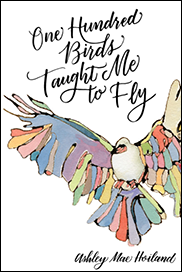Review
======
 Title: One Hundred Birds Taught Me to Fly: The Art of Seeking God
Title: One Hundred Birds Taught Me to Fly: The Art of Seeking God
Author: Ashley Mae Hoiland
Publisher: Neal A. Maxwell Institute for Religious Scholarship
Genre: Religion
Year Published: 2016
Number of Pages: 213 + xxiii
Binding: Softcover
ISBN13: 978-0-8425-2992-1
Price: $12.95
Reviewed by Jenny Webb for the Association for Mormon Letters
The latest book in the Neal A. Maxwell Institute’s Living Faith series, *One Hundred Birds Taught Me to Fly: The Art of Seeking God* by Ashley Mae Hoiland has been the recipient of many kind, thoughtful endorsements and reviews of late. I am happy to have the chance to add my voice to the list of those saying “This is an important book. This is a beautiful book. This is a book you should read, and read again.” Because it truly is that, and more.
Hoiland has a creative soul. This much is clear from even a cursory glance at the various facets of her work. She paints. She fosters community art projects. She’s written and illustrated children’s books. She’s the force behind the We Brave Women cards. And here, in this book, she writes.
She writes poetry, she writes prose; she tells stories from her childhood and stories of her children; she records lists that spark recognition memories that bridge the gaps between her life and mine. Her writing is devotional, with a sharp intelligence that calmly questions her faith without undermining its potency. Through it all, through all the words, and all the line drawings (which, of course, Hoiland has done herself to illustrate both the book and the larger connection between aesthetics and faith), she seeks gods.
For Hoiland, God can be found, but often not where we think we will find him. And he is not alone: Heavenly Mother is a very real, potent, generative force both in Hoiland’s life and in the art she then creates. So while the journey Hoiland undertakes here falls well within the models and modes of past seekers—the pilgrim, the mystic, the poet—the actual terrain covered in this journey is decidedly Mormon: parents, siblings, spouses, children, friends, and family, and friends as family.
Hoiland returns thematically again and again to an idea illustrated by her story of a runner named Rose. In the story, both Hoiland and the as-yet-unnamed runner have undertaken a significant challenge: the half marathon. Without any discussion, and without even actually looking at each other, they find each other at near the beginning of the race and begin to run together.
“For the next six miles we paced with each other. She jogged in place while I retied my shoes. I walked with her when she slowed down up the hills. We walked together, still without a glance or a word between us up the foreboding incline of mile eleven as music blasted in our respective headphones. I wondered what she was listening to. In the final mile my strength was gone, and I thought I might have to stop, but the stranger I had run the whole race with gave me a thumbs-up.”
“We crossed the finish line together, and then upon stopping we turned and hugged tightly, sweat dripping down our necks and backs. She said, ‘I could not have done this without you.’ I was surprised to hear she had a strong accent. Her name was Rose. We took a photograph together, hugged once more. It will be a miracle if we ever run into another again in this life.” (152)
The acknowledgement of the grace that arises from community—”I could not have done this without you”—is the gift that Hoiland gives again and again throughout her attempt to meld the beauty of a specific, material human life with the grainy grandeur of eternity. Gods surface in surprising places, and Hoiland’s own gift is an ability not only to see that grace and beauty, but to believe in it.
She believes in people. She believes in them when she encounters them in graveyards in Sweden accompanied by her two young children. She believes in them when she finds them beneath the open skies of Uruguay as a missionary. (Side note: It turns out we served in the same mission, though she much later than I of course. I’m not often moved by sentiment while reading, but her absolute love of a people I have loved, and continue to love, was, for this reader, breathtaking.) She believes in them when she marries them, when she births them, when she returns to them, and even when she fails to find them.
Hoiland turns people into art. And that is a graced gift. One that fosters community, yes, but also one that, at its heart, is fundamentally Mormon. Reading *One Hundred Birds Taught Me to Fly* was a delight, yes, but also a treasure. I am thrilled to see this volume in the Living Faith series, both for what it illustrates about faith, but even more, for how beautifully it cares for the art of living as a living together here, and now, where it counts.
